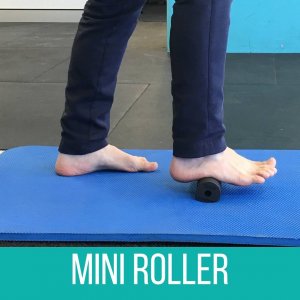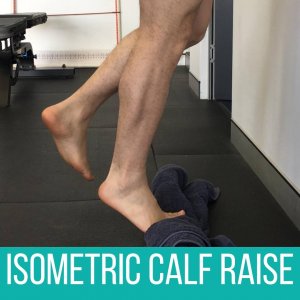Plantar Fasciitis Exercises For Runners

Here at Active Movement Studio we often see runners coming in after a sharp increase in running loads that put a lot of stress on our bodies and make our joints, ligaments and tendons all a little bit unhappy, especially if the increase in load is large and sudden.
One of the most common areas where this overload occurs is at the Plantar Fascia of our feet; a condition previously known as Plantar Fasciitis but a more accurate term would be Plantar Fasciopathy as the injury has a more degenerative than inflammatory nature (Riel et al. 2017). We will continue to use the commonly used Fasciitis term for this article.


How do I know if I have Plantar Fasciitis?
The Plantar fascia is a band of connective tissue that runs from the heel to the ball of the foot. It consists of 3 bands: lateral, central and medial. One of its main roles is to keep the bones and joints in position and enable us to push off from the ground. The most common site of Plantar Heel Pain is near the origin of the central band at the base of the heel.
Here is a quick checklist to determine if you might have Plantar Fasciitis:
- Have you increased the load of your running e.g. faster running speed or increased the number of hills ?
- Have you changed your running shoes or changed your running style?
- Do you have pain in the heel or foot first thing in the morning?
- Does the pain improve once you have warmed up?
If you answered Yes to any of the above questions, there is a good chance that you are experiencing some form of Plantar Fasciitis. Make sure to speak to your Physiotherapist to get an accurate diagnosis.
Is it OK to run with Plantar Fasciitis?
It depends if it is acute or chronic….
If it the Plantar Fasciitis is acute (less than 6 weeks) then we recommend you let it settle down and avoid running. In Physiotherapy terms we call this a Reactive tendon that will only get angrier with more load. Keep reading below to see our top 3 exercises to reduce your pain and get you back to running ASAP!
But as the saying goes, prevention is the best cure. To safe-guard yourself against Plantar-Fasciitis, choose your shoes wisely, try and avoid excessively high or low heels; go for shoes with a low to moderate heel that provides good arch support and shock absorption. Try not to train running barefoot, especially on hard surfaces and replace your worn-out runners after 500kms of use.
Should you Exercise with Plantar Fasciitis?
YES!
Top 3 Plantar Fasciitis Exercises for Runners
The goal of the initial stage is pain-focused, with the aim to settle down your pain in the acute Plantar Fascia.
Here are our top 3 Acute Plantar Fasciitis Exercises for Runners:
1. Blackroll Mini Roller

Complete 5-10 minutes of rolling per day.
2. Isometric calf raise

Aim for 3 sets of 30 seconds (remember to work in a pain free range).
3. Isometric Toe Flexion

Aim for 3 sets of 30 seconds (remember to gradually increase the pressure).
The above exercises will continue to build strength and reduce pain! As you reduce the running load during the acute reactive phase, make the best of the time off by working on your core, pelvic and hip control. Quite often we find runners with Plantar Fasciitis have associated hip and core weakness. You can find some great low load core exercises on our Pilates blog article.
The second stage is the return to sport and gradual re-loading phase, to increase your chronic workload and rehab the plantar-fascia to better tolerate running or sport specific stresses. The Physiotherapists at Active Movement Studio work closely with the Exercise Physiologists to structure your individualised exercise loading program, this ensures you have the best chance of returning to running without an injury relapse.
How long does Plantar Fasciitis take to heal?
Plantar fasciitis is a self-limiting condition and the length of symptoms will vary from person to person. The condition should resolve within 3-6 months. In the research; 80% of patients with plantar heel pain had a full resolution of symptoms within a 12-month period.
The more important question of course is when can I run again? A study by Rathleff and colleagues in 2015, recommends that you should be able to walk 10km and be pain free for 4 weeks before starting to run again. Again, each person is different. When your pain has settled, try going for a short 5-minute run and observe how you feel the next day. If the pain doesn’t return, then you have a baseline to work with to gradually increase your running load again.
The Physios at AMS are experts in diagnosing, treating and managing running related injuries. Book in now to see a Physiotherapist and so we can get you back on the road running !
References:
Gabbett T.J. (2015). The training-injury prevention paradox: should athletes be training smarter and harder? British Journal of Sports Medicine; 0: 1-9.
Hulin B.T., Gabbett T.J., Lawson D.W. et al. (2015). The acute:chronic workload ratio predicts injury: high chronic workload may decrease injury risk in elite rugby league players. British Journal of Sports Medicine.
McPoil, T.G., Martin, R.L., Cornwall, M.W. et al. (2008). Heel-pain: Plantar fasciitis: Clinical practice guidelines linked to the international classification of function, disability, and health from the Orthopaedic section of the American Physical Therapy Association. Journal of Orthopaedic and Sports Physical Therapy; 38(4).
Porter D., Barrill E., Oneacre K., May B.D., (2002). The effects of duration and frequency of Achilles tendon stretching on dorsiflexion and outcome in painful heel syndrome: a randomized, blinded, control study. Foot Ankle Int. 23: 619-624.
Rathleff, M.S., Molgaard, C.M., Fredberg, U. et al. (2015). High-load strength training improves outcome in patients with plantar fasciitis: A randomized controlled trial with 12-month follow-up. Scandinavian Journal of Sports Medicine; 25(3) 292-300.
Riel H., Cotchett M., Delahunt E., et al. (2017). Is ‘plantar heel pain’ a more appropriate term than ‘plantar fasciitis’? Time to move on. British Journal of Sports Medicine; 51 (22).

